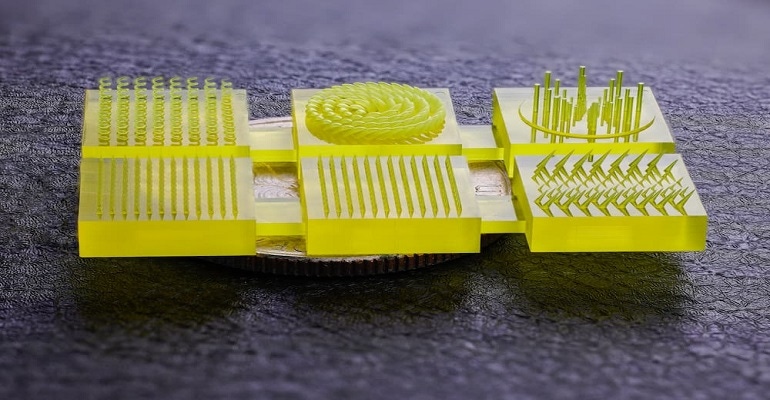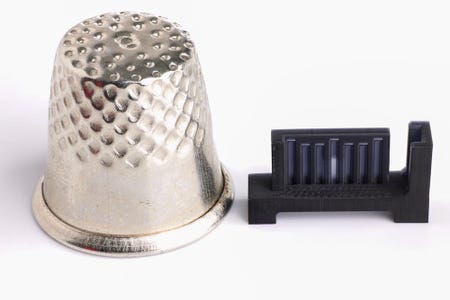How to Build Tiny Products by Using Microfabrication Techniques
Here’s an explanation of why to use projection micro stereolithography for resolution, accuracy, and precision to print viable parts on a micro-scale.
July 3, 2023

Boston Micro Fabrication uses projection micro stereolithography (PµSL) for microfabrication in 3D printing. This digital micro-display technology provides stereolithography masks that work as virtual photomasks. This technique allows for rapid photopolymerization of an entire layer with a flash of UV illumination at micro-scale resolution. The mask can control individual pixel light intensity that allows control of the material properties of the fabricated structure with spatial distribution.
Projection micro stereolithography (PµSL) printers separate themselves from other 3D printing techniques by utilizing the benefits of both DLP and SLA technologies. PµSL involves printing in the top-down direction of SLA. However rather than using a small spot laser, the entire image, or a section of the image is cured as done in DLP. A thin plastic membrane is consistently stretching and leveling the uncured resin within the vat. This process fabricates micro-sized parts with accurate resolution at much faster speeds than traditional microfabrication techniques. By using PµSL, current additive users can push and extend the limitations of traditional SLA and DLP technologies while new users can unlock capabilities within their business that were once unachievable.

We caught up with Phil Mooney, an applications engineer at Boston Micro Fabrication, to get more details on PµSL.

Design News: Tell us about the Projection Micro Stereolithography (PµSL) technology for microfabrication.
Phil Mooney: Projection Micro Stereolithography (PμSL) is a technique that allows for rapid polymerization of a layer of liquid polymer using a flash of UV light at micro-scale resolution. The PuSL process differs from other DLP processes in that it incorporates high-precision optics, high-precision motion control, and mechanical systems and software to control the pixel precisely and accurately through a top-down light source. The vat of resin moves throughout the build allowing for larger parts or arrays of parts to be built while maintaining tight tolerances and consistency over the full build area.
This process fabricates micro-sized parts with top-notch resolution, at much faster speeds than traditional microfabrication techniques. By using PµSL technology, current additive users can push and extend the limitations of traditional SLA and DLP technologies while new users can unlock capabilities within their business that were once unachievable.
DN: What materials are involved?
Phil Mooney: BMF’s open micro 3D printing material system allows you to print with our specially formulated liquid polymers or to print with the material of your choice. BMF currently has eight materials that are compatible with the microArch line of 3D printers. Each material offers different properties depending on the end user’s application. Included in this roster are three biocompatible materials, an engineering-grade production material with good aging properties, a heat-resistant material that can withstand temps of 200°C, and an alumina ceramic material.
With collaborations with some of the largest material manufacturers in the world, 20,000 cp printing capability, and access to thousands of resins, you have a variety of options available that will allow you to achieve the results you need based on your application. One of these such collaborations is with LOCTITE 3955, a high-performance halogen-free flame retardant UL94-V0 high modulus photopolymer resin.
DN: What are some application examples for micro parts?
Phil Mooney: The ultra-high resolution, accuracy, and precision that BMF delivers are key to a number of verticals including medical device manufacturing, optics and photonics, microfluidics, electronics, wearables, and drug delivery. For instance, one of our largest customers 3D prints electronic connectors in LOCTITE 3955. Medical device applications span one-time medical component use, optical component housing for endoscopes and other devices as well as microneedle patches for vaccine delivery.
DN: Do you work with your customers to determine which parts are needed? Are most of your products custom-made?
Phil Mooney: We are in the process of working with numerous customers on production applications. In general, however, we manufacture and sell the equipment and are always happy to print a benchmark part at no cost for evaluation as part of the sales process. We have a number of partners across the globe that print and sell BMF parts in a bureau capacity.
DN: What are the size limitations for the technology and the materials?
Phil Mooney: The largest build envelope is 100 x 100 x 75mm, on the microArch S240, 10µm 3D printer. PμSL 3D printing incorporates advanced optics to control the pixel size down to smaller values, which directly translate to a higher resolution. Controlling the pixel down to smaller sizes allows for PμSL 3D printing technology to print at a much smaller minimum feature size (think 1 pixel = 2μm square, which means 10μm minimum feature sizes are possible), while also maintaining high precision and accuracy.
About the Author(s)
You May Also Like





